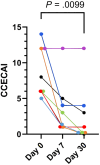Effect of a single rectal fecal microbiota transplantation on clinical severity and fecal microbial communities in dogs with chronic inflammatory enteropathy
- PMID: 39778887
- PMCID: PMC11710856
- DOI: 10.1111/jvim.17264
Effect of a single rectal fecal microbiota transplantation on clinical severity and fecal microbial communities in dogs with chronic inflammatory enteropathy
Abstract
Background: Fecal microbiota transplantation (FMT) has been advocated as a treatment for chronic enteropathy (CE) in dogs. However, so far only short-term clinical effects have been reported whereas the effect on the microbiota remains unexplored.
Hypothesis/objectives: Assess if a single FMT enema can lead to clinical improvement in dogs with CE when accompanied by presumed favorable microbiota changes. The effect of glycerol as a cryopreservative when storing FMT preparations also was assessed.
Animals: Seven dogs with CE that received FMTs from 2 healthy donor dogs.
Materials and methods: Six dogs received a single FMT, 1 dog received 3 consecutive FMTs. Canine chronic enteropathy clinical activity index (CCECAI) and fecal samples were obtained before (Day 0), and 7, 30 and 90 days after FMT. Samples were stored with and without 10% glycerol. Sequencing of microbiota (16S rRNA, Illumina) was performed and compared by accepted analysis pipelines.
Results: Median CCECAI before FMT was 8 (range, 5-14), decreased to a median of 3 (range, 1-12) within 1 week and a median of 1 (range, 0-12) by Day 30 (P < .01), with an average duration of response of approximately 10 weeks. Significant variation in the donors' microbiota composition was observed across different donations. Recipient microbiota composition or diversity did not change over time. Glycerol addition was associated with a difference in microbiota composition (P ≤ .001).
Conclusions and clinical importance: A single FMT can be considered an appropriate treatment in dogs with CE, but consistent microbiota changes were not observed.
Keywords: bacteria; diarrhea; inflammatory bowel disease; microbiome; transfaunation.
© 2025 The Author(s). Journal of Veterinary Internal Medicine published by Wiley Periodicals LLC on behalf of American College of Veterinary Internal Medicine.
Conflict of interest statement
Authors declare no conflict of interest.
Figures








Similar articles
-
Investigating fecal microbial transplant as a novel therapy in dogs with inflammatory bowel disease: A preliminary study.PLoS One. 2022 Oct 18;17(10):e0276295. doi: 10.1371/journal.pone.0276295. eCollection 2022. PLoS One. 2022. PMID: 36256653 Free PMC article.
-
One dog's waste is another dog's wealth: A pilot study of fecal microbiota transplantation in dogs with acute hemorrhagic diarrhea syndrome.PLoS One. 2021 Apr 19;16(4):e0250344. doi: 10.1371/journal.pone.0250344. eCollection 2021. PLoS One. 2021. PMID: 33872339 Free PMC article.
-
Observational Study of Small Animal Practitioners' Awareness, Clinical Practice and Experience With Fecal Microbiota Transplantation in Dogs.Top Companion Anim Med. 2022 Mar-Apr;47:100630. doi: 10.1016/j.tcam.2022.100630. Epub 2022 Jan 10. Top Companion Anim Med. 2022. PMID: 35021112
-
Fecal Microbiota Transplantation in Dogs.Vet Clin North Am Small Anim Pract. 2021 Jan;51(1):219-233. doi: 10.1016/j.cvsm.2020.09.012. Epub 2020 Oct 29. Vet Clin North Am Small Anim Pract. 2021. PMID: 33131919 Review.
-
The Super-Donor Phenomenon in Fecal Microbiota Transplantation.Front Cell Infect Microbiol. 2019 Jan 21;9:2. doi: 10.3389/fcimb.2019.00002. eCollection 2019. Front Cell Infect Microbiol. 2019. PMID: 30719428 Free PMC article. Review.
References
-
- Dandrieux JRS. Inflammatory bowel disease versus chronic enteropathy in dogs: are they one and the same? J Small Anim Pract. 2016;57(11):589‐599. - PubMed
-
- Craven M, Simpson JW, Ridyard AE, Chandler ML. Canine inflammatory bowel disease: retrospective analysis of diagnosis and outcome in 80 cases (1995‐2002). J Small Anim Pract. 2004;45(7):336‐342. - PubMed
-
- Allenspach K, Wieland B, Gröne A, Gaschen F. Chronic enteropathies in dogs: evaluation of risk factors for negative outcome. J Vet Intern Med. 2007;21(4):700‐708. - PubMed
MeSH terms
Substances
Grants and funding
LinkOut - more resources
Full Text Sources
Medical

